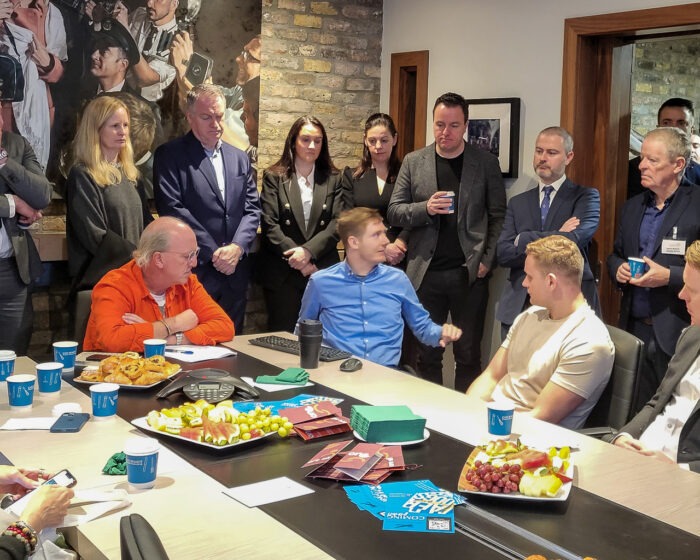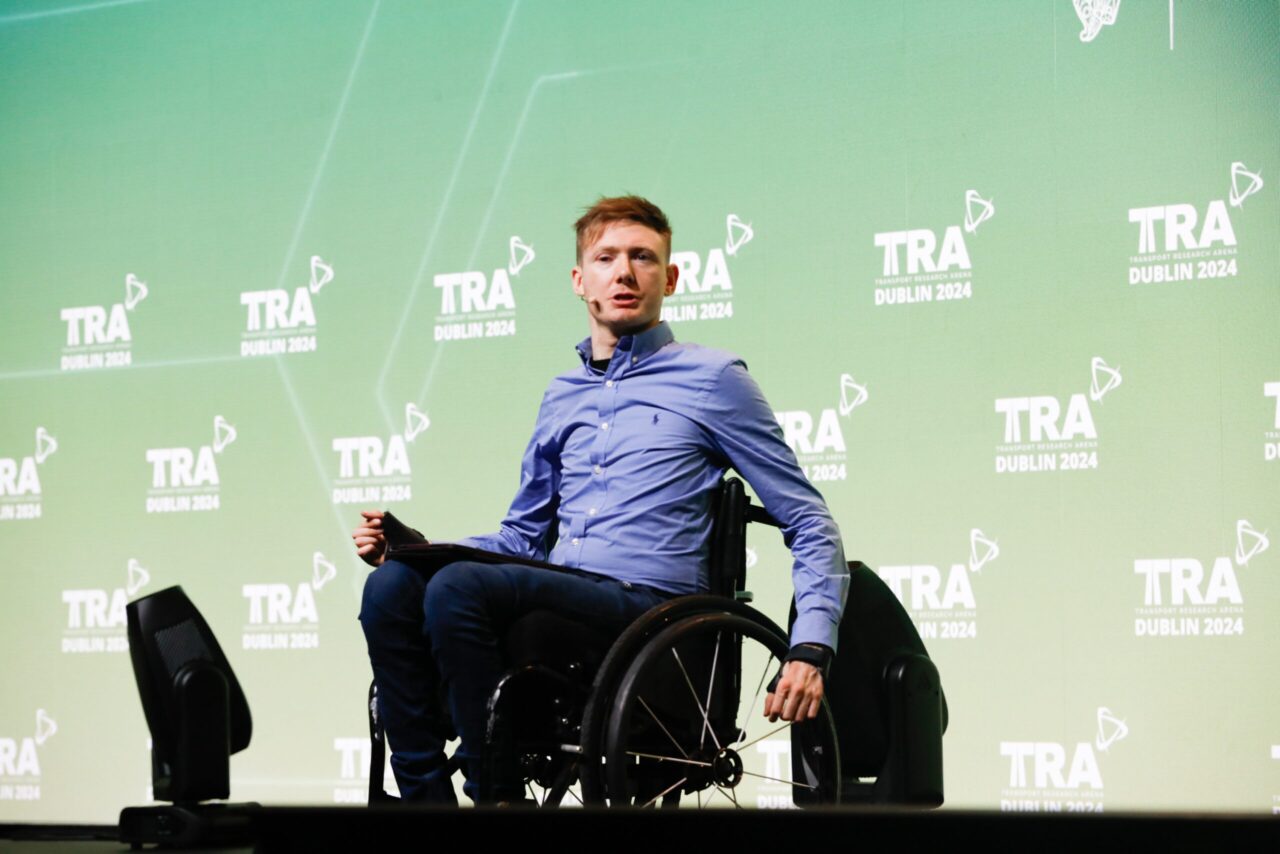Jack Kavanagh shows me a photograph.
Kavanagh, who twelve years ago suffered a life-changing spinal cord injury after a swimming accident, is well-versed in discussing the issues faced by people with reduced mobility when they travel on an aeroplane.
But, to really get the point across, Kavanagh, a wheelchair user, often uses images. In this one, he is sitting in a so-called aisle chair, a non-specialist chair designed to fit down the narrow passageway of a plane, after travelling the Atlantic to speak at an aviation innovation conference in Washington last June.
“Getting off the plane my wheelchair takes another thirty minutes to arrive, and I have the indignity of being strapped into what they call an aisle chair,” said Kavanagh. “I am sitting there strapped in while all the passengers for the next flight board on their way back to Dublin.”
Kavanagh shows me another picture.
In this one, he has a red cut on his forehead. “I was thrown into my seat and sort of cut my head,” he explained.
Kavanagh, 32, knows he is not alone. He is a non-executive director of the National Disability Authority and has many friends who are also wheelchair users. He knows the difficulties they face. Often, many opt not to travel by plane, isolating themselves from the world around them.
About one per cent of the world, 80 million people, use wheelchairs or have significantly reduced mobility. As the world’s population grows, this number is rising.
“People with reduced mobility represent a growing passenger segment,” Kavanagh said. “In addition over one billion people will be aged over 65 in 2030 so there is going to be much greater demand for support in the future.”
About a year ago Kavanagh began to think about campaigning to make planes more accessible to wheelchair users worldwide. Based on his own experience, he started to post on social media about the problems he and others were facing.
It caught the attention of Declan Ryan, a serial aviation entrepreneur who has listed three airlines on the stock market including Ryanair. Ryan asked Kavanagh to give a presentation a year ago to airline leaders in his office in Dublin ahead of the annual Airline Economics conference.

In a packed room, Kavanagh told his story to aircraft manufacturers, lessors, airline executives and regulators. It was a compelling one.
Kavanagh soon decided to do more. He founded the AeroFix Project with the singular mission of “enabling an end-to-end journey for a wheelchair user without leaving their assistive device”. Declan Ryan’s Irelandia offered to support him as did SMBC Aviation Capital and a number of others in the sector.
The “Magic Triangle”
A year has passed since Kavanagh briefed that packed room and he has been busy.
He gave keynote speeches at the 4,000 delegate Transport Research Arena conference when it was in Dublin last year. He has met the EU Disability Federation and the Passenger Rights Team in the EU Commission for Transport. He has also met with aircraft manufacturer Airbus, airlines Ryanair and Delta, as well as specialists like aviation design consultants PriestmanGoode to discuss what role technology can play.
Gradually, the AeroFix Project has focused on creating and campaigning for the so-called “Magic Triangle” for wheelchair users. This involves first building a technical aeroplane seat solution that allows people to travel onto a plane in their wheelchairs and stay in it safely during flights.
The second vertex to a solution is creating an app to make booking flights easier for wheelchair users and airlines as well as ensuring people’s transport on and off the plane and through airports is faster and a better experience. The third part of the triangle is creating a new bathroom design for wheelchair users who currently sometimes can’t even access a toilet on board.
Kavanagh said the AeroFix Project was also taking a three-pronged approach to meeting the various parties required to change things. “It has been apparent from the beginning that to make progress it is necessary to engage and collaborate on three levels, with the innovators who develop products, the regulators who certify the products and the legislators who create the rule book,” he said.
Kavanagh said there was recognition in the aviation industry that things had to improve. “We’re at an inflection point. There are significant changes in legislation coming, being led by the American side. It’s at a place now where either this is embraced as an opportunity or it will become a very big problem for aviation,” he said.
He said he had seen progress all year culminating in Montreal in November at a joint symposium about accessibility in international aviation held by the three most powerful organisations in world aviation namely the International Civil Aviation Organisation, the Airports Council International and the International Air Transport Association.
Kavanagh attended the two-day event attended by the most powerful figures in aviation. The theme was: “Inclusive and universally accessible Air Transport for Persons with Disabilities and Reduced Mobility.”
“It was the sweet spot. The fact they put it on the agenda at such a big event for global aviation. It was really very powerful,” Kavanagh said.
Kavanagh said the US Department of Transportation (DOT), which he has met with, was taking the issue of accessibility seriously. On October 23, 2024, the DOT fined American Airlines $50 million for “numerous serious violations of the laws protecting airline passengers with disabilities between 2019 and 2023”.
Kavanagh said these kinds of material fines were also helping the aviation industry to sit up in America. Kavanagh said more actions were coming in the United States and legislation was in the works to ensure people with reduced mobility are treated better. He said Europe was lagging behind America, but that he was hopeful it would catch up.
A demographic not going away
Jack Kavanagh said a year into the AeroFix Project he sees the campaign as at “cruising altitude.”
“The danger is that you become complacent when you’re at cruising altitude,” he said. “There’s a balance between me being patient and maintaining urgency in what we do. It is called the AeroFix Project because we want it to be time bound. We want to get in, make an impact, and get on with our lives.”
Kavanagh said his goal this year was to keep “mission centricity” on enabling end to end travel for persons with reduced mobility. He said that would mean continuing to lobby, speak-out and network with the different stakeholders in the aviation industry.
He said for airlines besides being the right thing to do – figuring out how to treat people with reduced mobility better would increase their turnaround times allowing them to make more money and be fined less for delays. “Aviation is a very tightly regulated and legislated industry. If they are mandated to change across the board then airlines will get on and do it,” Kavanagh said. “That’s the way it appears to be going but we have to stay focused on ensuring that happens.”
“The proportion of the population that have reduced mobility is only going to rise. It’s only 30 years ago that people were institutionalised. Now they’re out in the world and travelling not just for pleasure, but also for work. This demographic is not going away, and I think that is being recognised by aircraft manufacturers and the airlines.”


